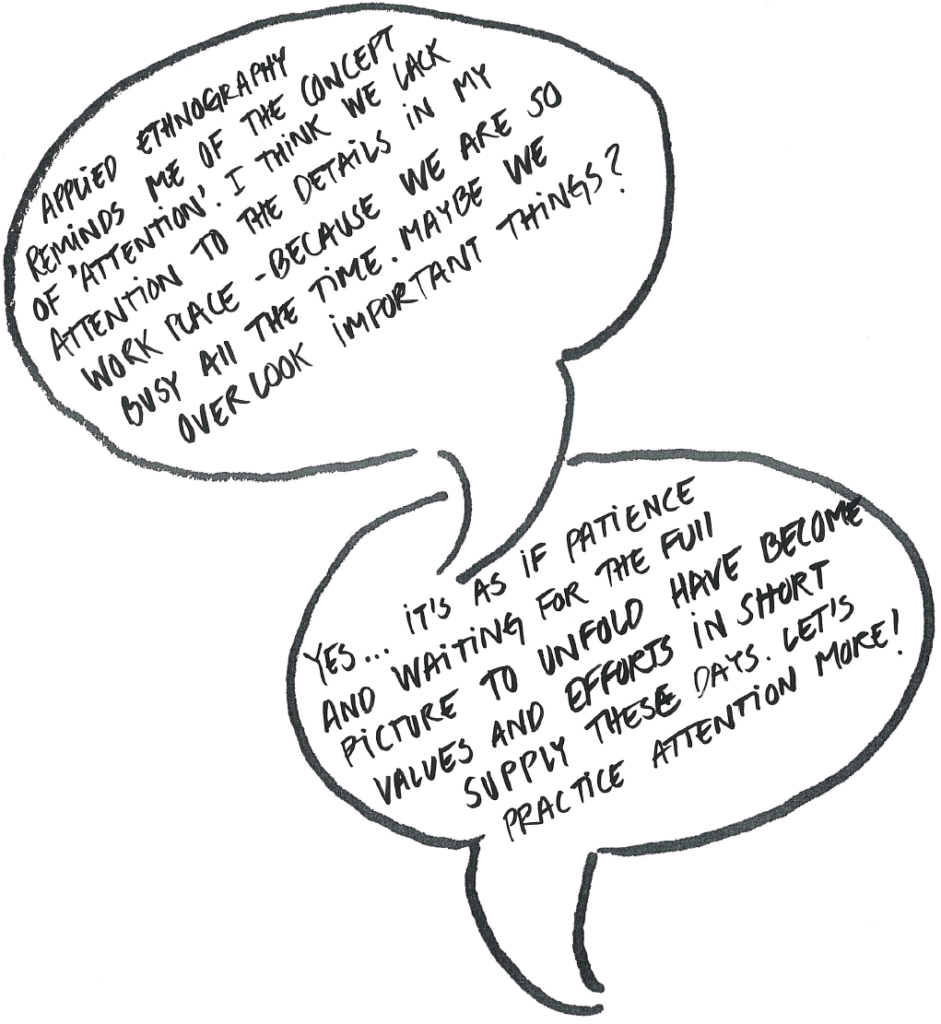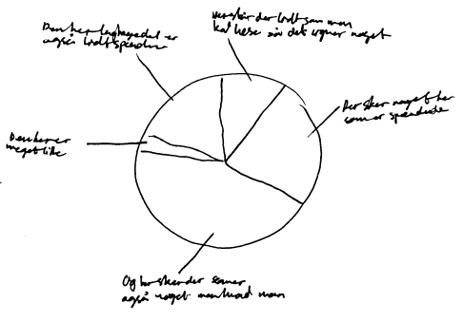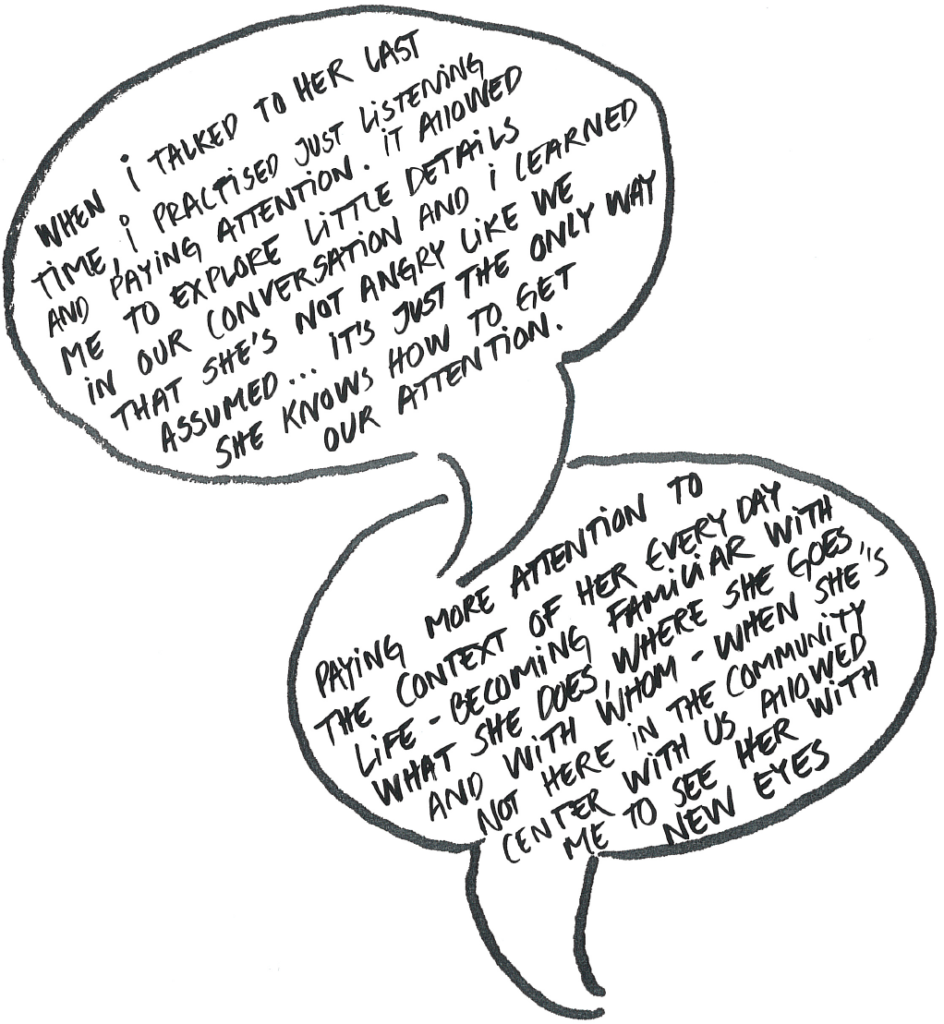Understanding applied ethnography – reflection or discussion exercises

When you are done with the observation and writing exercises, then read the following excerpts from a conversation between two Danish social workers, discussing applied ethnography.
I think that—more as a mode of being than a style of writing—applied ethnography can become a sustainable way of coping with my work and perhaps avoid burnout. We’ve discussed in our team if applied ethnography is too emotionally charged, but I don’t think it has to be. It’s not about my feelings, it’s about sensitivity, about being. The devil is in the detail.
Elisa
We see people in these Kafkaesque situations all the time and if we approach our work in a brutalized manner just acting as troubleshooters, it will kill our integrity and professionalism. It will put an expiration date on our professionalism and conflict with our ethics. I think that applied ethnography holds the potential of enhancing our contextual understanding and allow us to see the broader picture, for example better understanding how bureaucracy is affecting the everyday lives of our service users. In that sense, applied ethnography has the potential for further development that can protects us from brutality, taking the time to listen, help us walk away from a “that’s not possible” reflex, and move us back to seeing both our own work and the human being we’re working with more clearly. Being present and observant will allow us to ‘put the intervention mode’ on pause … our profession has become so accelerated and sometimes bureaucratic with its focus on time management and results. Maybe applied ethnography can help us to slow down. The effect of actually taking the time to listening and be curious will show in the excel sheet in the end.
Frey
Different target groups have different behaviors that can be cumbersome or problematic, but as an ability to really observe the full context, applied ethnography allows me to better see and understand what people are doing and why. It allows me to not just see their behavior as cumbersome, but to place ‘it’ somewhere else, maybe more as a response to a context. It makes it easier to maintain good relations when I take a good look at how the environment influences service users’ behavior. I also start to notice parameters in their environment, which can create reserves of energy or strength. When looking behind just the relation I have with them, I get a glimpse of the coping strategies that they have adopted and that I otherwise might not had noticed. This qualifies my work.
Elisa
Because it makes me focus more on the context, applied ethnography allows me to better understand how place and space changes and affects social relations. I become more likely to ask myself how I ‘decode’ the actions and behavior of the people I meet in my professional life. I’m beginning to ask myself ‘If I knew more about the context of this person’s life what would I then pay attention to?’ It’s the small things … last week during one of our team-meetings, we talked about one of our service users, a young homeless guy who has been incapable of meeting consistently. Now he’s developed a routine of coming here every day and participating actively, so my colleagues have begun to require more of him. He’s not very good at taking care of himself, so he appears untidy. So, one of my colleagues had asked him to take a shower before coming in next time—and it jeopardized his sense of being in a safe space. It made me think how such questions would be formulated if we consider the broader context of people’s lives. Instead, the question could have been ‘I wonder where you spend your nights?’ And perhaps ‘if you need help finding a place to shower and wash your clothes?’ As it has triggered many discussions about our organizational culture, including the ways in which our everyday culture shapes our interpretations and conclusions, the example has been interesting to us. One of my colleagues has tried to really understand the broader context of his life. In all the social work contexts of his life, he is known as an aggressive and introvert type. Recently, he was called in for a meeting at the job center. It was mentioned in the notice for the meeting that there would be security guards present. He has a history of being intimidating, and that history seems to predetermine all encounters with ‘the system.’ But from conversations and observations, my colleague knows that when he is feeling bad and is super-frustrated because he can’t get any positive attention or help, he starts to become threatening. For example, as a cry for help, he will stand in a crowded place in the city and threaten to shoot people … not because he’ll carry out such an act, but just to be picked up by the police so ‘someone’ does something. The stories about him—depicting a person who is potentially dangerous—have shaped how we as professionals in our organization have faced him; with reservations and calls for more a more ‘appropriate’ behavior and appearance. What really impressed me was the ways in which my colleague used her knowledge about the broader context of his everyday life and behavior to question our assumptions and predetermined expectations. She dared to ask us if there’s something in our culture and implicit expectations of appropriate behavior that autopilots us with reservations towards him … asking what might happen if we understand his behavior as a skewed attempt of socializing and just tolerate his untidiness until he has mobilized enough energy to figuring out where to take a bath? What happens if we simply celebrate the small fact that he comes here five times a week and says “Hi” to a couple of people every day instead of getting caught up in our own expectations?
Frey

- Based on the excerpts above, discuss if you recognize the issue with organizational culture or practices that predetermines your view on people and problems.
- Based on your experience with your organizational culture and practices, discuss what you are respectively good at, and can become better at, noticing in encounters with people and problems.


- Based on the illustration, discuss the ways in which you can challenge and break with organizational culture or practices that predetermines your view on people and problems (if it helps you, you can make your own illustration based on case of familiarity to the group) .
- When writing, how do we communicate information about significant details that we might not have a solution for?
- What happens with a text if we switch the resource- and problem perspective?
- How can applied ethnographic writing skills inform, and perhaps qualify, sparring with colleagues?
- What happens with our collective understanding of a person or problem if we use our contextual knowledge?